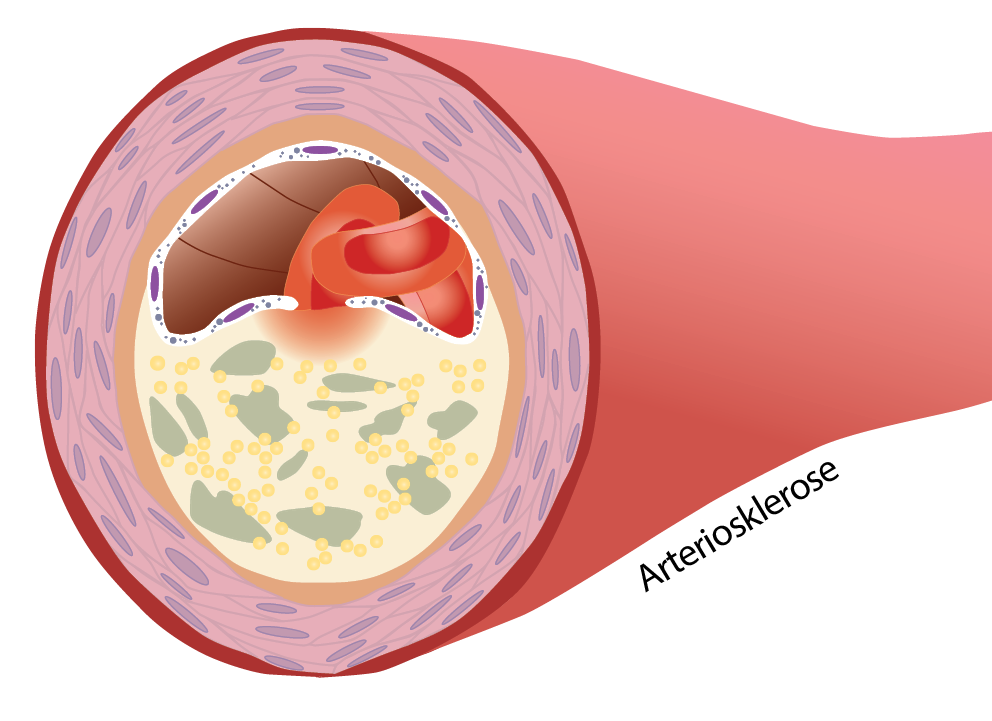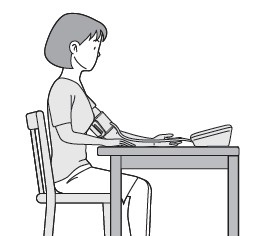High blood pressure (hypertension)
the unnoticed risk to your health
Treat in time - maintain heart health
Our heart - a fist-sized and about 300g "heavy" lightweight. 70ml of blood per beat, 5 litres of blood per minute, 7000 litres of blood per day and 2 million litres of blood over the course of an 80-year life. Our heart performs this task continuously and without maintenance. At present, no machine in the world can compete with this necessary performance. But what happens when this machinery comes to a standstill?
What is high blood pressure?
High blood pressure, also called hypertension, is one of the most common chronic diseases. In many cases there is also diabetes and a disturbance in fat metabolism. An accompanying disturbance in fat metabolism leads to an additional narrowing of the blood vessels, which in turn leads to a further deterioration in blood pressure. These diseases often develop insidiously and unnoticed, resulting in a risk to your health. Continued damage to the cardiovascular system can lead to acute events such as a heart attack or stroke. At the same time, chronic impairment of other organ systems can develop.
Every human being has a certain pressure in the blood vessels, also known as vascular pressure. This pressure is generated by the ejection force of the heart. The heart is thus the "motor" of the blood flow, which circulates throughout the body and ensures the supply of oxygen and all nutrients. In an adult the optimal blood pressure is below 120/80 mmHg. A high pressure is present when, after several measurements, the values rise above 140/90 mmHg. For a reliable diagnosis and also to check the therapy applied, it is best to take a so-called 24h blood pressure measurement.
Neither age nor sex protects against high blood pressure. It is estimated that currently about one third of the population is affected by high blood pressure.
What makes high blood pressure so dangerous?
High blood pressure overloads the heart and vessels. The heart has to beat with extra force and can become unnaturally enlarged, which in turn leads to an increased oxygen demand. The vessels constrict and can become rigid and inelastic. As a result, the blood supply to the brain, kidney and heart itself is reduced. Together with smoking and increased blood lipid levels, high blood pressure is therefore one of the most dangerous risk factors for cardiovascular disease.
Hypertension that is inadequately treated or not treated at all often causes no symptoms at all for a long time. However, in old age risk factors such as overweight, lack of exercise, diabetes and lipid metabolism disorders can lead to high blood pressure. The following complications can result:
- Cardiac insufficiency up to and including heart attack
- Stroke
- Circulatory disorders in the legs (arteriosclerosis)
- Vascular damage to the kidneys and eyes
What are the causes of high blood pressure - what can I do?
In 95% of people, no organic cause for hypertension can be found. Families often have an accumulation of this disease. Unfortunately, this genetic predisposition cannot be changed, but in connection with today's often very unhealthy lifestyle, one contributes significantly to a negative influence on blood pressure. The key points listed below have an influence on blood pressure that should not be underestimated:
Overweight
Try to reach your target weight by eating a varied and low calorie diet. Already a weight reduction of 5 kg lowers the blood pressure by 10 (!) mmHg. If you have a normal weight, try to maintain this weight in the future.
Lack of exercise
The average walking distance we cover during the day is about 800 m. Ideally, however, we would walk about 5km or 10,000 steps per day. People with health restrictions or predominantly sedentary jobs should urgently increase their range of movement. As an alternative to visiting a gym, all kinds of endurance exercise such as hiking, walking, running, cycling and swimming are recommended. Nowadays, adult education centres, health insurance companies and physiotherapists offer supervised and financially affordable services.
Increased cholesterol intake and excessive salt consumption
Within the framework of a healthy and balanced diet, there are a few things that should be considered in the long term:
- Reduce animal fats as sources of cholesterol (spreadable sausage, offal, fatty meat and bacon).
- If possible, fall back on high-quality vegetable oils and fats.
- A moderate use of fats in the preparation of food (fried foods, buttered vegetables, ready-made dressings) is recommended.
- Increasing the fibre intake, e.g. by wholemeal products, has a positive effect on the cholesterol level.
- The daily salt requirement of an adult is 3-5g, in fact we consume twice that amount on average. Sensitive persons react to increased salt intake with an increase in blood pressure.
Nicotine consumption
Smoking is one of the biggest risk factors in relation to high blood pressure. The nicotine contained in tobacco is a vascular poison and stimulates the production of stress hormones in our body, such as adrenaline. This causes the blood vessels to constrict and blood pressure to rise for up to 20 minutes. At the same time, smoking leads in the long term to vascular calcification (arteriosclerosis) with corresponding consequences such as circulatory disorders in the heart, brain and leg arteries.
Excessive consumption of alcohol
The per capita consumption of alcoholic beverages is clearly too high. Since alcohol is an important factor in the development of high blood pressure, reducing alcohol consumption can subsequently improve the risk. Furthermore, alcohol is an energy supplier that should not be underestimated.
Stress
Our stress hormone adrenaline causes the heart rate and therefore also the blood pressure to rise. If you are exposed to such a situation permanently or for a longer period of time, regardless of whether it is psychological or physical, chronic high blood pressure can be the result. Try to compensate for stress through leisure activities. Stress management programmes can also be helpful in individual cases. If diabetes is another underlying disease, it is of decisive importance to keep blood sugar levels within the therapeutic target range in order to avoid additional damage to the vascular system caused by elevated sugar levels.
How does high blood pressure become noticeable?
Many people feel very well for a long time despite high blood pressure and have no complaints. Others, however, complain of headaches, dizziness, shortness of breath and tiredness. The headaches usually appear in the morning and disappear again after an hour or two. However, these symptoms can also have other causes - regular blood pressure checks help to clarify the symptoms.
The right blood pressure self-measurement
There are basically two different types of measuring instruments. Devices for measurement on the upper arm and devices for the wrist. Get professional advice to choose the right device for you.
The blood pressure of a person measured in a doctor's practice is often higher because the so-called "white coat effect" has an influence that should not be underestimated. Measurements in a home environment, provided the measuring device is in perfect working order, are more meaningful and therefore more suitable for the doctor's therapy decisions. It is important that the values are correctly documented. Blood pressure diaries make this easier. An often underestimated source of error is the cuff size. Select the size that is right for you according to your measured upper arm circumference.
Only measurements taken at the same time of day can be compared. This allows conclusions to be drawn as to whether a medication is effective over the desired period of time. When changing blood pressure medication, it can be useful to check your blood pressure regularly without putting yourself under "pressure". However, you should not measure your blood pressure more than 6 times a day, as this can cause damage to the blood vessels. The measurement should always be taken on the same arm and approximately at heart level. Tight-fitting long-sleeved clothing should be taken off before the measurement (do not roll up the sleeve), as this can lead to incorrect values.
- Measure in a relaxed sitting position after at least 3-5 minutes rest
- The measurement should always be taken on the same arm and approximately at heart level.
- Tight-fitting long-sleeved garments should be taken off before the measurement (do not roll up the sleeve), as this can lead to incorrect values.
- Immediately before the measurement: heavy physical exertion and excitement should be avoided.
- Do not drink large amounts of liquid immediately before the measurement and empty your bladder as much as possible.
- Alcohol and nicotine should be avoided at least 1 hour before.
- The time of the last intake of any antihypertensive medication should be recorded.
- The first measurement should be taken on both arms. If there are major differences, further checks must be made.
- For control measurements always on the arm with the higher blood pressure reading - usually the left arm (near the heart).
- If consecutive measurements are taken, pause for at least one minute.
A range of drugs - which ones are available?
High blood pressure cannot be reduced without appropriate measures. However, hypertension can only be successfully treated in cooperation between doctor and the affected person. The treatment is tailored to the individual person. First and foremost, this includes advice on lifestyle issues such as sports activities, weight reduction and nutrition.
Different active ingredients are available to the doctor for the treatment of high blood pressure. If one medication alone is not sufficient, combination preparations or additional substances are often used. The list below provides a brief overview of the most important groups of drugs used to treat high blood pressure.
ACE inhibitors: inhibit the release of stress hormones
Beta-blockers: reduce the pumping power of the heart and the heart rate
Calcium antagonists: dilate and relax the blood vessels
Diuretics: increase urine and therefore also salt excretion via the kidneys and reduce blood volume
Angiotensin receptor blockers and renin inhibitors: intervene in the hormonal regulation of blood pressure and the formation of vasoconstrictive substances
In connection with blood pressure medication, there are a number of things to be considered:
- Always take your prescribed medication regularly and as directed by your doctor.
- Please refrain from independent changes in dosage and from discontinuing medication on your own authority.
- The medication should always be taken at about the same time.
- Tablets should only be taken with water. Juices, dairy products and coffee are not suitable.
- If you experience any side effects or intolerances, please speak to your doctor immediately.
You can also find this and other texts as a guide to Download as PDF.
Claudia Donath, Astrid Hofmann and your MED TRUST Team



